Tennessee’s incredible terrain includes majestic mountains, deep valleys, and fertile plains and plateaus. So the many plant species in the Volunteer State are just as varied and divine. Yet among the vast expanse of Tennessee plants, dangerous ones are lurking in plain sight. These poisonous plants use toxins as a defense against predators, including humans who touch or eat them. Therefore, it’s in our best interest to learn about poisonous plants and respect their boundaries. Toward that goal, let’s discover nine poisonous plants in Tennessee you should avoid and the toxins that make them dangerous.
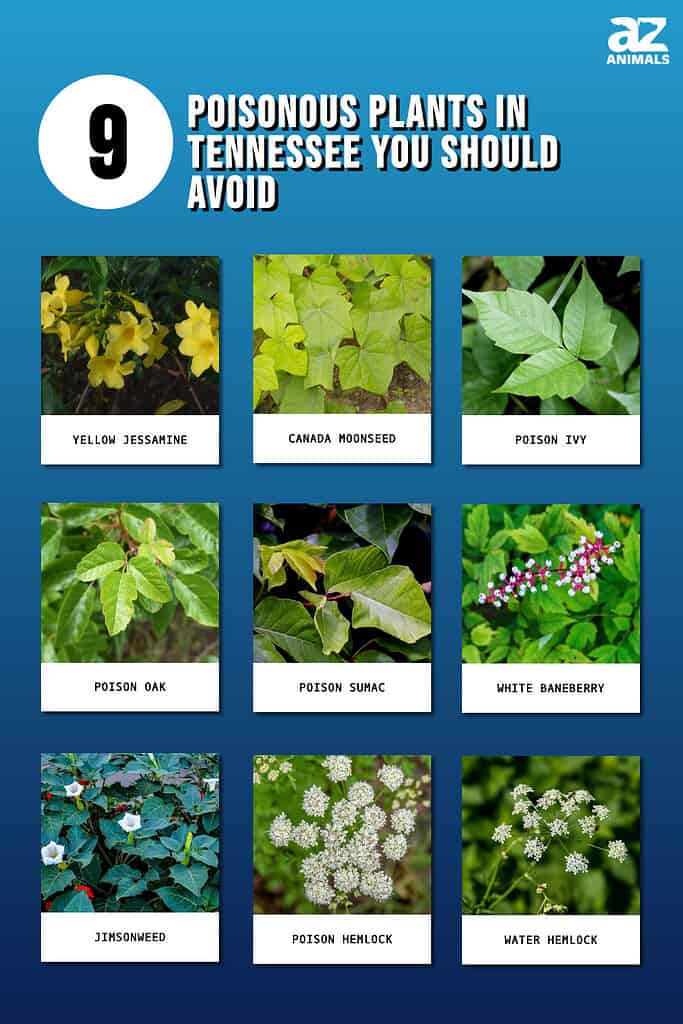
1. Yellow Jessamine (Gelsemium sempervirens)
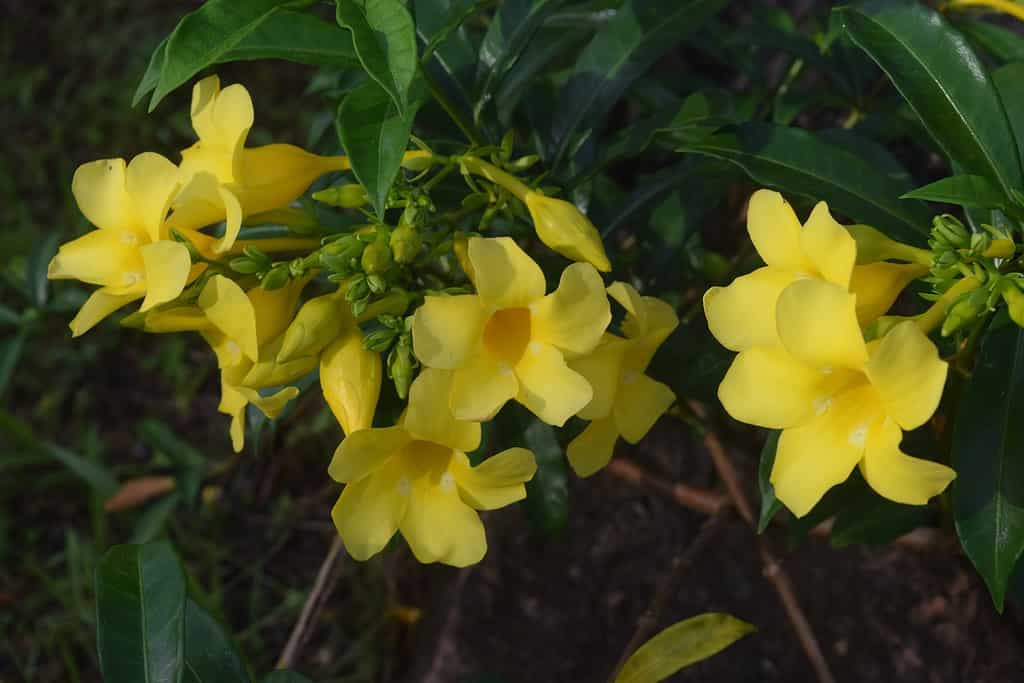
Yellow jessamine vines while fragrant are also poisonous.
©Ayobelajargo/Shutterstock.com
The yellow jessamine, or Carolina jessamine plant, is a climbing vine with bright yellow trumpet-shaped flowers. Its oval, pointed leaves are shiny and dark green. And the yellow jessamine vine has a lovely fragrance. However, this poisonous plant in Tennessee is a threat to grazing livestock because it’s attractive and smells so sweet.
Yellow jessamine grows along fences and in wooded areas. It’s also a desirable garden plant. However, due to its toxicity, be aware of the risks of growing yellow jessamine around children, pets, and livestock.
The Toxins in Yellow Jessamine
Unfortunately, beautiful yellow jessamine vines are full of neurotoxic alkaloids, including gelsemine and gelsedine. Ingesting any part of a yellow jessamine plant could cause severe symptoms like muscle weakness, paralysis, convulsions, and respiratory failure.
2. Canada Moonseed (Menispermum canadense)
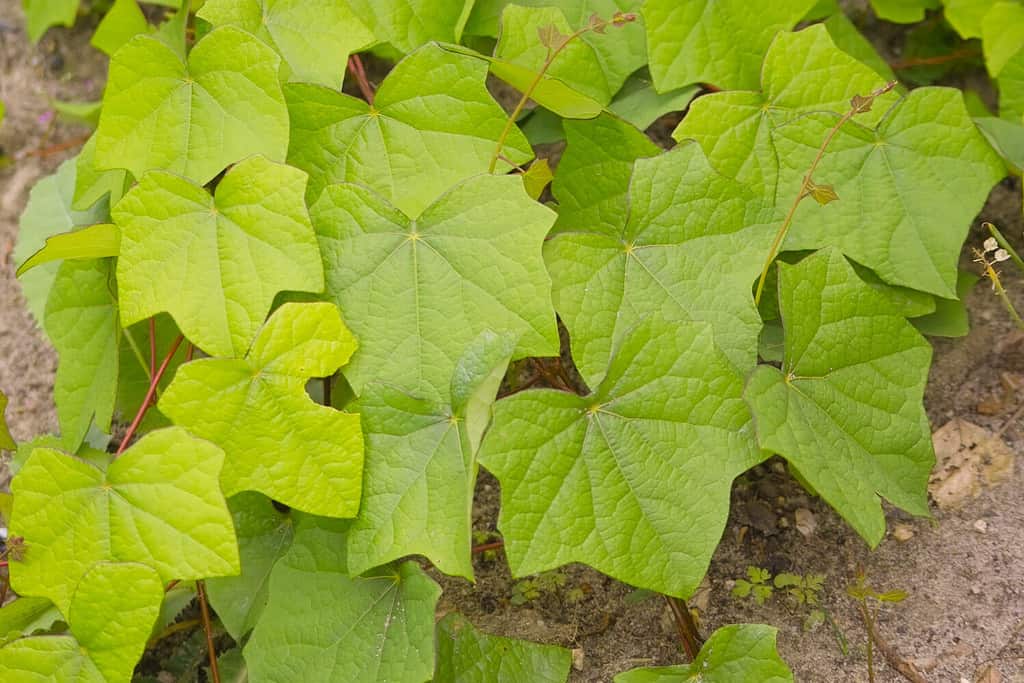
Canada moonseed is a woody poisonous vine with heart-shaped leaves.
©Ole Schoener/Shutterstock.com
Moonseed, or Canada moonseed, is a woody vine with heart-shaped leaves and small, dark drupes (fruit) with crescent-shaped seeds. This poisonous plant in Tennessee resembles a grapevine with its similar ovate leaves. In addition, this poisonous plant can grow up to 30 feet tall or long.
Canada moonseed thrives in wet, wooded areas, thickets, and stream banks. But this perennial vine requires caution because of its toxic alkaloids.
The Toxins in Canada Moonseed
Dauricine, an alkaloid, is the main toxin in moonseed plants. And dauricine is highly toxic, causing serious poisoning symptoms if ingested. The symptoms of moonseed poisoning include severe gastrointestinal distress (diarrhea, vomiting), hallucinations, confusion, convulsions, and potential organ damage leading to death.
3. Poison Ivy (Toxicodendron radicans)
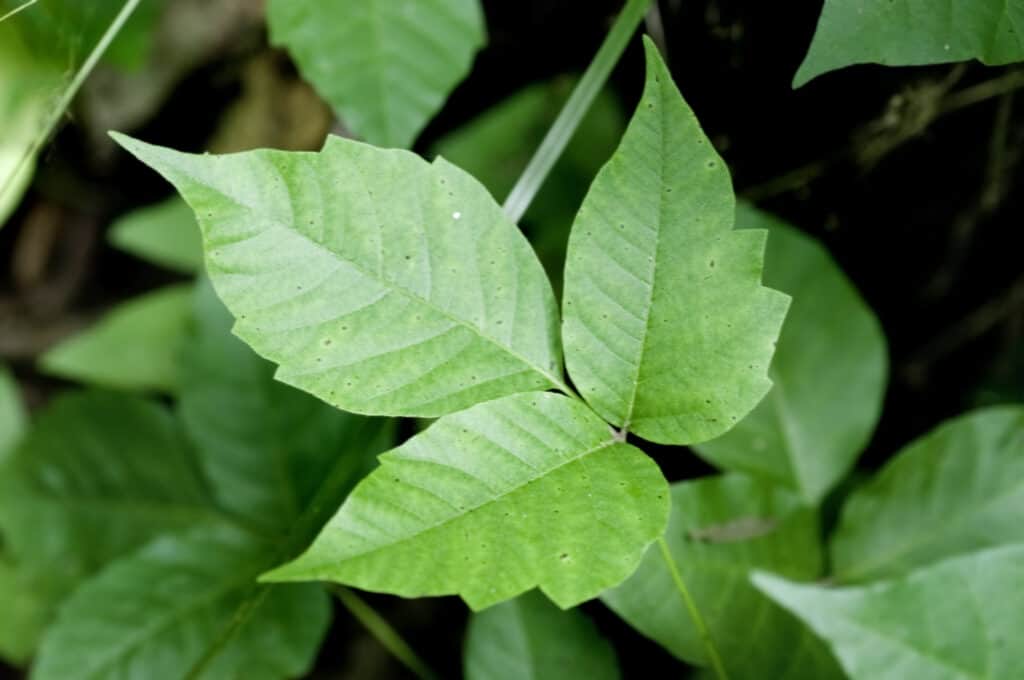
Poison ivy is recognizable by its 3-leaflet foliage pattern and its climbing growth habit.
©Tim Mainiero/Shutterstock.com
Rash-including poison ivy is a vine or shrub that grows sets of 3-leaflets that make it easy to recognize. Poison ivy leaves may have a slightly reddish tinge in the spring and turn vibrant red-orange in the fall. And this poisonous plant can creep its way up tall trees or along wooded trails up to 75 feet! But don’t confuse poison ivy for another creeping Tennessee plant called the Virginia creeper.
Poison ivy thrives in woodlands and on the edges of forests or pastures. Plus, poison ivy is a quickly-growing plant that loves to sun itself near streams and river banks too.
The Toxins in Poison Ivy
Urushiol is a toxic oil that poison ivy produces. Unfortunately, when humans touch poison ivy, the urushiol gets on their skin and usually causes an allergic reaction. Symptoms of poison ivy poisoning include skin redness, rash, itchiness, and blisters. In severe cases, these symptoms might last up to two weeks.
4. Poison Oak (Toxicodendron pubescens)

Poison oak leaves tend to grow longer and slightly more rounded than the leaves of poison ivy plants.
©ShutterstockProfessional/Shutterstock.com
Eastern poison oak is a low-growing shrub or climbing vine with leaves grouped in threes, similar to poison ivy. And, like poison ivy, poison oak grows along wooded areas, in fields and grasslands, and near the banks of rivers and streams. So wherever you find this poisonous plant in Tennessee, poison ivy might also be nearby.
How can you tell poison oak from poison ivy? The leaves of poison oak have a slightly different shape, similar to those of an oak tree. Poison oak leaves are also longer and a bit more rounded than poison ivy leaves.
The Toxins in Poison Oak
So what’s the difference between the toxicity of poison oak and poison ivy? Actually, they’re very similar because both plants contain the same main poisonous oil called urushiol. Unfortunately, the urushiol oil in poison oak makes this plant an uncomfortable skin rash waiting to happen. Symptoms of poison oak poisoning include redness, swelling, rash, itching, and skin blistering.
5. Poison Sumac (Toxicodendron vernix)
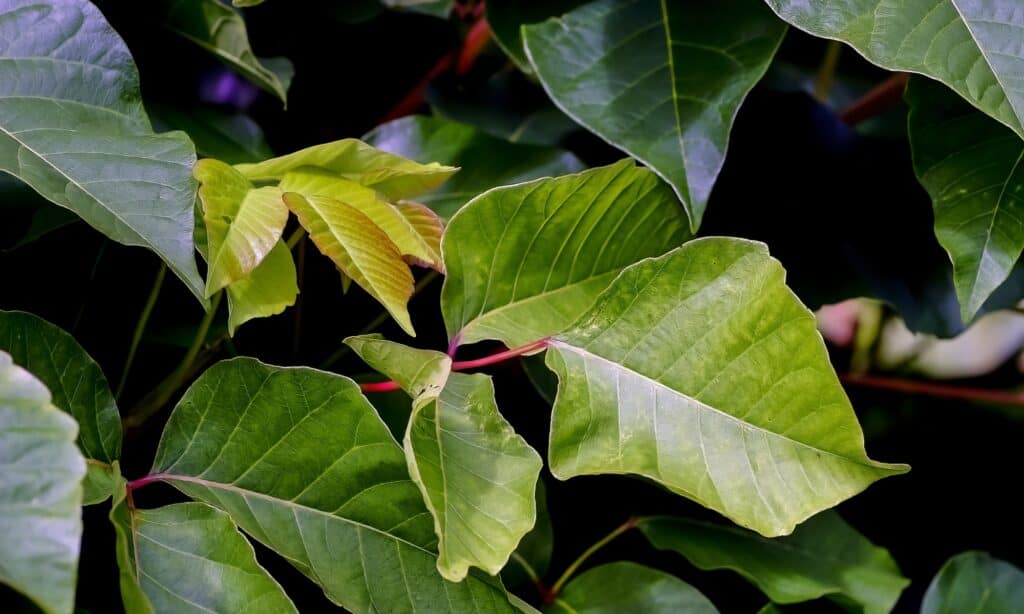
Poison sumac often grows in the soggy soil of marshes, swamps, and bogs.
©iStock.com/Werner Meidinger
Woody-stemmed poison sumac is a small tree or tall shrub with red stems and clusters of oval leaves arranged in a row of 7-13 leaflet pairs. Poison sumac also features greenish-white hanging berries.
The poison sumac is a water-lover, as it thrives in wet areas of Tennessee with soggy soil like swamps, marshes, and bogs. And it’s another plant full of toxic compounds you don’t want to touch with your bare hands.
The Toxins in Poison Sumac
Urushiol is the starring toxin yet again, like in poison oak and poison ivy. However, the chemical structure of poison sumac toxins is slightly different. And this plant also causes stronger allergic reactions that may last longer than poison ivy or oak.
Symptoms from touching poison sumac include skin conditions like raised bumps, redness, an itchy rash, and blisters filled with fluid.
6. White Baneberry (Actaea pachypoda)
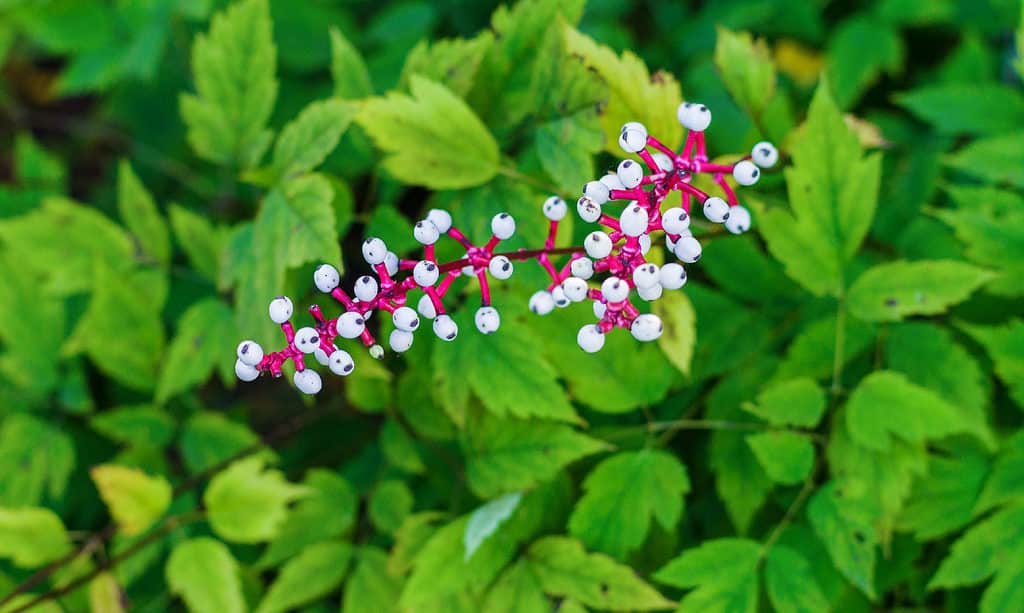
White baneberry plants feature iconic white berries with black dots that look like tiny eyes.
©Alex Polo/Shutterstock.com
The “doll’s eyes” plant, or white baneberry, features unique white poisonous berries with a dark dot on each. White baneberry also has branching foliage with thick stalks and oblong, toothed leaves arranged in 3-leaflets.
You can find this poisonous plant in Tennessee habitats that offer lots of shade. For example, white baneberry grows in thickets, woodlands, and deciduous forests.
The Toxins in White Baneberry
White baneberry contains cardiogenic toxins and an unstable glucoside called ranunculin. These toxins make this plant poisonous to animals and humans. Ingesting any part of white baneberry plants could cause nausea, vomiting, diarrhea, stomach cramps, delirium, rapid pulse, dizziness, circulatory failure, and cardiac arrest.
7. Jimsonweed (Datura stramonium)
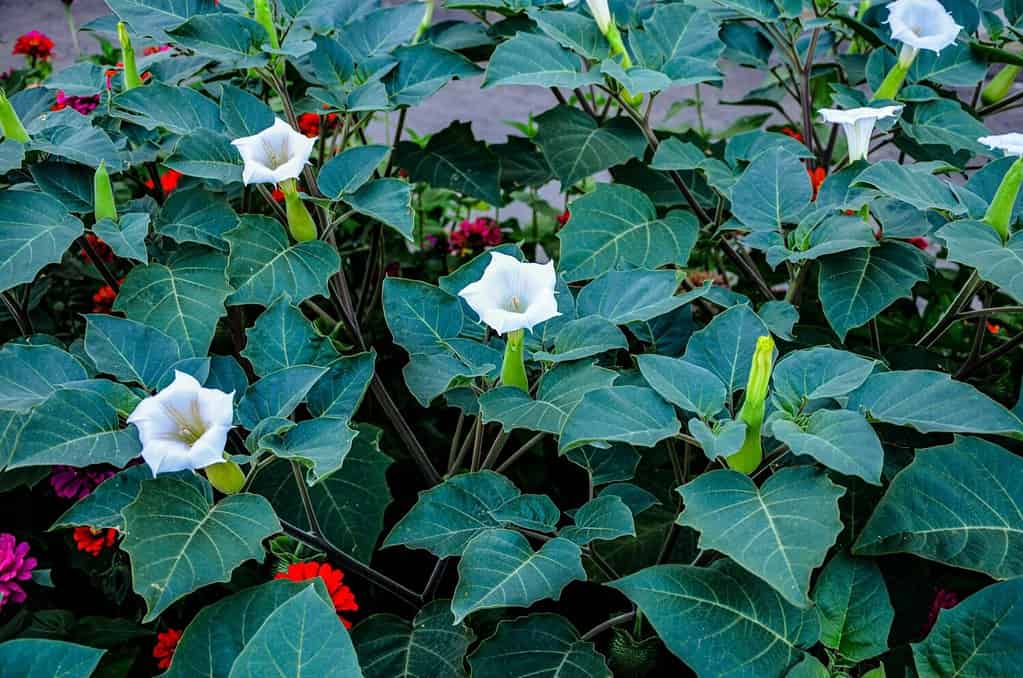
The jimsonweed plant contains toxic alkaloids that can cause severe symptoms like convulsions and coma when ingested.
©weha/Shutterstock.com
The jimsonweed plant is bushy and robust. It has large, lobed leaves and trumpet-shaped flowers in white, violet, and lavender hues. However, this striking plant also smells terrible. And it has a toxin load that’s dangerous if any parts of it are ingested.
Watch for jimsonweed plants in disturbed areas, fields, agricultural areas, and along roadsides. Or it may end up in your yard if there’s a jimsonweed stand close by because each plant produces up to 25,000 seeds!
The Toxins in Jimsonweed
The entire jimsonweed plant contains toxic alkaloids, including atropine and scopolamine. These toxins can cause severe symptoms when ingested, like hallucinations, rapid heartbeat, dry mouth, dilated pupils, confusion, coma, and possibly death.
8. Poison Hemlock (Conium maculatum)
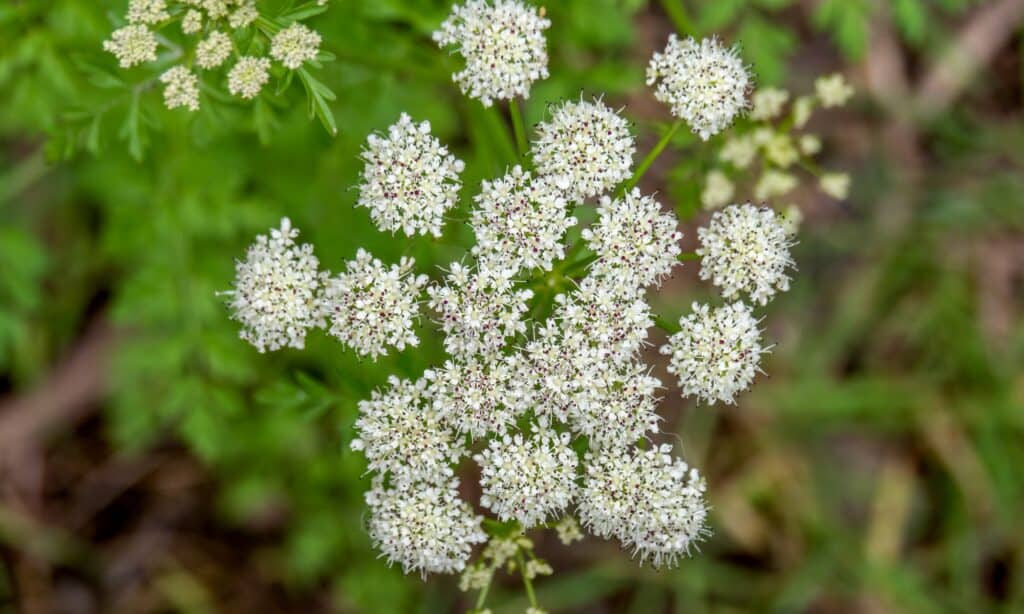
Poison hemlock is one of the most toxic plants growing in Tennessee and the US.
©iStock.com/Goldfinch4ever
Dangerous poison hemlock is a tall, erect plant with fern-like leaves, spotted stems, and clusters of small white flowers arranged in umbrella shapes (umbels). Poison hemlock and water hemlock (see below) are two of the most dangerous plants in the United States, including Tennessee.
Beware of poison hemlock growing in drainage ditches, along roadsides, in open fields, and near the banks of streams and rivers. When you find it, admire this poisonous plant’s beauty from afar.
The Toxins in Poison Hemlock
Poison hemlock produces highly toxic alkaloids, including one called coniine. Touching poison hemlock could cause a painful rash. Ingesting any part of poison hemlock plants could lead to burning sensations, dizziness, diarrhea, vomiting, respiratory failure, muscle paralysis, weakness, convulsions, coma, and death.
9. Water Hemlock (Cicuta maculata)
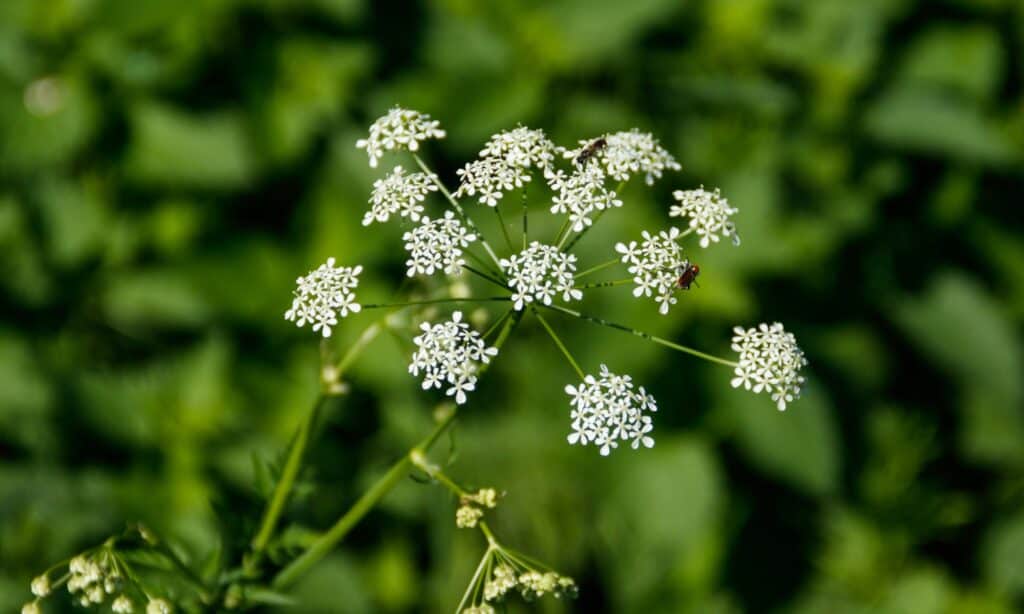
Ingesting any part of the water hemlock plant could cause respiratory distress, seizures, and death.
©iStock.com/OlyaSolodenko
Incredibly poisonous water hemlock produces umbrella-shaped clusters of small white flowers on its hollow, speckled stems. This toxic plant can grow up to 6 feet tall and thrives in wet soil along ditches, marshes, streams, and rivers.
Water hemlock, poison hemlock, and other plants in the hemlock family resemble certain edible weeds like wild parsley or wild carrots. So it’s crucial to know a hemlock plant when you see one so that you can avoid accidental poisoning.
The Toxins in Water Hemlock
The highly dangerous neurotoxin in water hemlock is cicutoxin. Ingesting any part of water hemlock plants could lead to nausea, vomiting, respiratory distress, seizures, and death.
Poisonous plants in Tennessee don’t need to be a threat.
Tennessee’s natural beauty is a treasure to behold, including its many plant varieties. But the poisonous plants lurking among the harmless ones can be bountiful too. Stay safe from poisonous plants in Tennessee by learning about their growth habits and toxicity. And help prevent accidental poisoning by wearing protective clothing and not touching unfamiliar plants. Contact poison control or call 911 immediately for help if plant poisoning occurs.
Summary of 9 Poisonous Plants Found in Tennesee
| Poisonous Plant | Toxicity | |
|---|---|---|
| 1 | Yellow Jessamine (Gelsemium sempervirens) | Contains neurotoxic alkaloids like gelsemine and gelsedine that can cause muscle weakness, paralysis, convulsions, and respiratory failure |
| 2 | Canada Moonseed (Menispermum canadense) | Contains dauricine, an alkaloid that can cause severe gastrointestinal distress (diarrhea, vomiting), hallucinations, confusion, convulsions, and potential organ damage leading to death |
| 3 | Poison Ivy (Toxicodendron radicans) | Toxin called urushiol causes itchy skin rash, swelling, and blistering |
| 4 | Poison Oak (Toxicodendron pubescens) | Also contains urushiol which causes redness, swelling, rash, itching, and skin blistering |
| 5 | Poison Sumac (Toxicodendron vernix) | Contains cardiogenic toxins that cause nausea, vomiting, stomach cramps, dizziness, rapid pulse, delirium, and circulatory failure that could be fatal |
| 6 | White Baneberry (Actaea pachypoda) | Contains cardiogenic toxins that causes nausea, vomiting, stomach cramps, dizziness, rapid pulse, delirium, and circulatory failure that could be fatal |
| 7 | Jimsonweed (Datura stramonium) | Toxins scopolamine and atropine can cause dry mouth, rapid heartbeat, confusion, dilated pupils, blurred vision, hallucinations, coma, and possibly death |
| 8 | Poison Hemlock (Conium maculatum | Powerful neurotoxins including coniine can cause weakness, nausea, vomiting, dizziness, convulsions, muscle paralysis, respiratory failure, coma, and death |
| 9 | Water Hemlock (Cicuta maculata) | Contains potent cirutoxin which causes tremors, seizures, respiratory failure, nervous system failure, and death |
The photo featured at the top of this post is © Alex Polo/Shutterstock.com
Thank you for reading! Have some feedback for us? Contact the AZ Animals editorial team.






